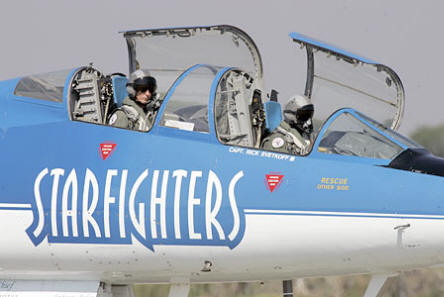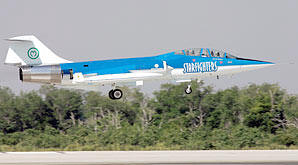Pilot's jet fighter business enjoys a boom
The sound tests may lead to
commercial spacecraft flights at Cape
Canaveral.
By CURTIS KRUEGER
Published April 18, 2007
|
Pilot Rick Svetkoff, right,
and co-pilot Dave Waldrop
taxi a F-104 Starfighter jet
along the tarmac Tuesday
during a test mission at the
Kennedy Space Center landing
facility in Cape Canaveral.
|
 |
| |
[AP photo]
|
Pinellas County businessman Rick Svetkoff
took two rides Tuesday in one of his company
vehicles -- at nearly 1,000 mph, and more
than 7 miles high.
He climbed into a fighter jet, zoomed off
a Kennedy Space Center runway and flew a
test pattern. The sonic booms he created
will help NASA decide whether to allow
commercial spacecraft to launch from Cape
Canaveral.
Svetkoff, who lives in Tarpon Springs
with his wife and two sons, has carved
himself an unusual niche. His company owns
four F-104 Starfighter jets, a type of
fighter formerly used by the U.S. Air Force
and others. He and other pilots fly them
around the country, mostly at air shows.
"I love it, it's the best job you can
get," he said, comparing his jets to
Ferraris. "Who wouldn't want to be a race
driver or fighter pilot? It's a great deal."
Svetkoff landed at the space center
Monday in a Starfighter that normally is
housed at St. Petersburg-Clearwater
International Airport.
|
 |
|
[AP photo]
A F-104 Starfighter
lands Tuesday at Kennedy
Space Center.
|
|
Like a lot of pilots, Svetkoff, 53, has
loved airplanes all his life. As a boy
growing up in Clarkston, Mich., he dreamed
of becoming a pilot. With money he earned
bagging groceries, he took flying lessons
and got a pilot's license at age 17.
After college, Svetkoff joined the U.S.
Navy in 1978 and flew A-4 fighter jets.
Thanks to his Russian surname, he was given
the call sign "Comrade." Svetkoff left the
Navy in 1984 and began a career as a
Continental Airlines pilot.
But within a few years, "I was kind of
anxious to get back into fighters again."
So in 1995, he bought his own fighter jet
for about $250,000, and poured more than
$1-million more into it to get make it
airworthy. This F-104 had been used by the
Royal Canadian Air Force and the Royal
Norwegian Air Force before Svetkoff was able
to buy it privately from a military
contractor.
"It's a high-performance, very sleek,
exhilarating airplane," Svetkoff said,
contending that it "still out-climbs and
out-accelerates the F-16."
In 1996, Svetkoff began flying at air
shows. After retiring from the airline about
a year ago, he devotes himself full time to
Starfighters. He has nine paid employees,
and they travel the air-show circuit.
Sponsorships help pay the bills.
But Tuesday's flights were not about
wowing the crowd below. Quite the opposite.
A handful of private companies are
developing ways to take "space tourists" on
journeys away from Earth. NASA is deciding
whether these spacecraft could take off from
Kennedy, which is better known for launching
America's Mercury, Gemini, Apollo and space
shuttle flights.
Most of the new vehicles would likely
take off like an airplane, or be carried
into the altitude attached to an airplane,
said Jim Ball, spaceport development manager
at Kennedy.
NASA believes that when the spacecraft go
supersonic, about 12 miles east of the
shoreline, they're not likely to make sonic
booms that would bother residents of the
Space Coast, Ball said.
Svetkoff's flight was designed to
evaluate whether that's true. Like the
anticipated commercial astronauts of the
future, he took off from the Shuttle Landing
Facility, the runway that was designed for
landing, but not launching, space shuttles.
He flew 40,000 feet, completed a loop
pattern and plunged back down to the space
center on a steep descent.
He also got to meet several astronauts
and NASA officials.
"I believe that's probably one of the
highlights of my life," he said afterward.
[Last modified April 17, 2007, 22:35:34] |